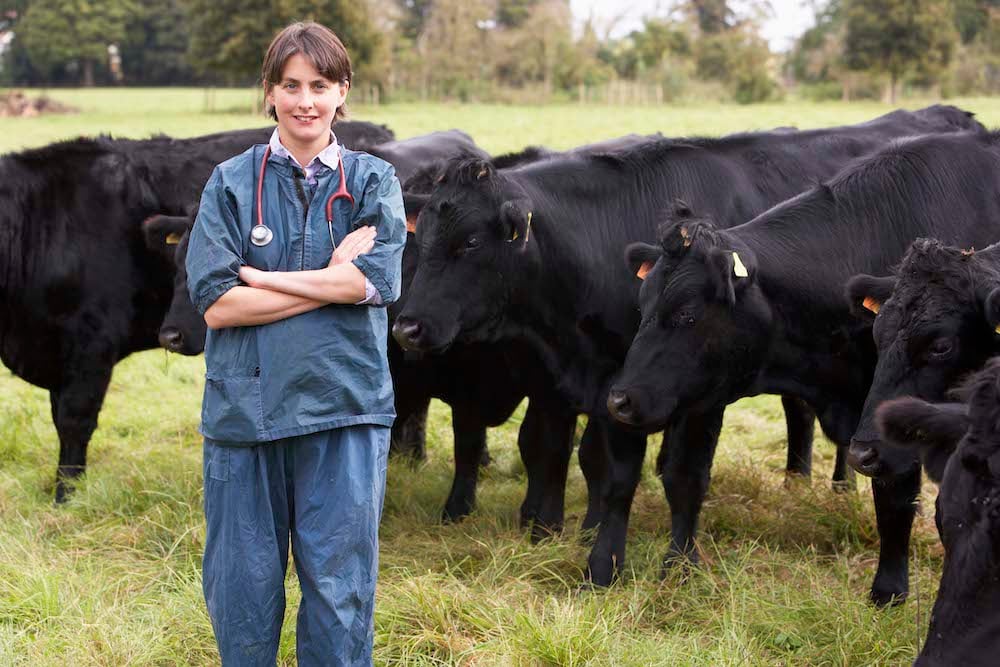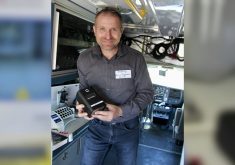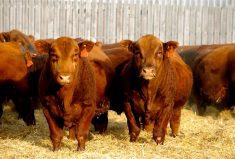Working in a rural community as a large animal veterinarian always made perfect sense to Dr. Trevor Lawson.

“There’s nowhere I’d sooner be because I came from a rural area and that’s where I always wanted to be,” says Lawson, who practices at Shubenacadie, Nova Scotia, specializing in bovine and equine care, and is an executive member of the Canadian Veterinary Medical Association.
Growing up on a beef farm and having family in the dairy industry made large animal practice a natural fit for Lawson. However, he recognizes that fewer aspiring veterinarians come from agricultural communities today, contributing to a complex problem for the profession and those they serve. Fewer applicants with a rural background “means it’s harder to get them out the other end as new graduates going into rural mixed practice and doing food animal practice,” he says.
Read Also

Body condition, nutrition and vaccination for brood cows
One of the remarkable events of the past century related to ranching has been the genetic evolution of brood cows….
Concerns about the shortage of large animal veterinarians in Canada are nothing new. “It’s been something we’ve been talking about for more than 30 years,” says Dr. Robert McCorkell, interim dean at the University of Calgary’s faculty of veterinary medicine.
This issue isn’t specific to large animal and rural mixed practice, however. The entire veterinary profession faces a shortage. Several countries around the world report an increased demand for veterinarians and veterinary technicians.
This shortage is the result of several factors, starting with the general population movement from rural to urban communities over the past several decades, meaning fewer students from rural communities. However, a student’s agricultural background isn’t a guarantee that they’ll return to practice in a rural area, just as many large animal veterinarians grew up in urban centres.
Once veterinary graduates are faced with finding their first clinical jobs, the realities of rural practice may deter them, compared to jobs in urban centres.

“I don’t know that the demand for food animal veterinarians has changed much in recent years. But the competition for veterinarians and veterinary technicians has increased markedly in urban areas to the point where starting salaries for veterinarians have gone up significantly and the conditions of employment that veterinarians are offered in urban centres continue to be very good,” says Dr. Jeffrey Wichtel, dean of the Ontario Veterinary College at the University of Guelph.
With emergency veterinary clinics in cities, veterinarians don’t necessarily have to be on call and have more opportunities to choose their hours, leading to greater work-life balance. In comparison, a rural practice may only employ a couple of veterinarians and require them to be regularly on call, with unpredictable schedules, long hours and more travel between calls.
“The calving season in the spring can be very busy and very intense, so you find that you don’t have much time to yourself. You’re working seven days a week for days on end,” says McCorkell. “That leads to burnout, and people are looking for working conditions that allow them more time to be with family.”
There’s also greater societal interest in animal care, both in companion and large animals, leading to rising demand for veterinarians. “I think there has been a real uptick in the interest and the appreciation for the value that animals have in our lives,” says Wichtel, adding that more people being at home during the pandemic has led to an increase in pet ownership.
“All of this has resulted in an increase in demand for veterinary services that, to be honest, we didn’t really predict.”
More new grads needed
“What’s happening now with the pool that graduates each year in Canada, it’s equivalent to around 2.9 per cent of the Canadian veterinary workforce, and there’s about a three per cent retirement rate. So it’s just kind of treading water,” says Lawson.
While foreign-trained veterinarians who become licensed to practice in Canada add to this stream, it’s still not enough, though there is discussion about helping those who graduated from programs not accredited with the Canadian educational model to upgrade so they can become licensed in Canada.
The Canadian Veterinary Medical Association is now creating recommendations based on this report, Lawson says, and is in discussions with stakeholders on how to meet this challenge. “Ultimately, it comes down to the need for licensing more veterinarians each year — and hopefully with regard to food animals — finding a way to get more applicants into vet school that come from a rural background, that have a desire to live in an agricultural region and work in the food animal sector.”

Increasing class size is no easy feat, however. While the class size at the University of Calgary’s faculty of veterinary medicine has recently increased from 30 to 50 graduates, McCorkell says “that doesn’t represent a net increase in veterinary graduates because our class sizing is increasing because the Province of Alberta repatriated the 20 seats that it had at the Western College of Veterinary Medicine to our faculty a couple of years ago.”
The University of Calgary is part of discussions to increase the number of graduates in Western Canada, though McCorkell notes that this is more complex, given the financial support needed to do so.
These discussions are occurring in Eastern Canada, too, with Ontario Veterinary College looking at increasing class size overall and the number of students interested in rural practice. “We are speaking to our provincial partners, our government partners, about this right now, and we hope that out of those discussions we will come up with a shared strategy to increase veterinary capacity and possibly veterinary technician capacity as well,” says Wichtel.
Both the Western College of Veterinary Medicine at the University of Saskatchewan and the Faculté de médecine vétérinaire (FMV) at the Université de Montréal have set aside seats specifically for students from rural communities. In the case of FMV, 15 seats were designated for rural students, each of whom will have a formal mentor in a large animal practice throughout their training.
“I believe that these initiatives are both very good starts, but we also need to re-assess the admissions process for veterinary school and determine how to reach young students to encourage them to pursue a career in large animal veterinary practice,” says Lawson.
This is another priority for Canadian vet schools. “If you spend a significant amount of time in your developing years in a rural environment, you’re more open to work in that space, you are used to that type of community and you can see yourself having a career in that area,” says McCorkell. “We’re looking at our admissions very closely to make sure that there aren’t barriers there to applications from potential students from rural placements.”
Mentorship and rural experience needed
“They spend at least several weeks in a rural community in their fourth year, so we’re introducing them to that environment and hopefully helping them understand what a career in that space would look like,” says McCorkell.
Mentorship is another aspect of this, says Wichtel, who feels Ontario Veterinary College can do more to encourage mentorship for students early in their veterinary education by partnering with rural practices across Ontario. This can also help students who didn’t grow up in agriculture but want to work in large animal practices build confidence. For example, around a quarter of Ontario Veterinary College’s students choose to specialize in food animal or mixed animal practice.
“A lot of those students are not from a rural area, but they love the idea of that kind of practice, and many of them end up going to their first job in a rural area. But they may find it very challenging if they’re not from a community like that,” he says.
“I think that strong period of mentorship can help them gain the confidence that they know the culture and language and business of farming so they can be more valuable to their farmer clients and therefore feel greater satisfaction in their work.”

In Quebec, provincial stakeholders created the Quebec Integrated Animal Health Program to increase agricultural vet numbers. As part of this program, FMV is working to “enhance the visibility of the profession, particularly in regions considered vulnerable to shortages … by contributing to the development of promotional tools aimed at students about the career of a farm animal veterinarian,” says Dr. Christine Theoret, FMV’s dean.
FMV is encouraging applicants who are more likely to be interested in large animal care by adjusting the admission process. The veterinary college is also exposing students to rural practice using methods such as networking events where students can meet young practicing vets working throughout the province. In partnership with FMV, the provincial agriculture department (MAPAQ) is now offering financial assistance for students who want to pursue summer internships in food animal practice in agricultural communities across Quebec.
Putting these strategies into practice is already shifting interest towards large animal practice, Theoret says. “Since the implementation of the MAPAQ internships in farm animal practice, a certain proportion of participating students have indicated that their choice of practice has changed from a city-based, small animal practice to a rural, food animal practice while others are considering this option,” she says.
Another strategy, which is pending approval and funding from the province, she says, is to “monitor the evolution of the workforce in farm animal practice by documenting the reasons for students’ career choices to better understand their needs and the factors that influence their decisions.”
Training vets in underserved communities
The plan was to “(draw) their medical students from that part of Ontario. They trained them as much as possible in that part of Ontario, they did all of their clinical placements in Ontario, and they emphasized the kind of competencies that a general rural practitioner needs,” says Wichtel.
“That’s, I think, the kind of innovative thinking we need to apply here because this problem isn’t going to go away this time.”
Ontario is encouraging beef producers to move into northern Ontario’s clay belt, adds Wichtel. “We cannot in good conscience have those economic development programs without ensuring that every animal has access to veterinary care.”
This model is currently being explored as part of the Quebec Integrated Animal Health Program. The proposal is to create a remote veterinary program at Rimouski, a partnership between FMV and the Université du Québec à Rimouski. The program is designed to encourage more veterinary students to stay in eastern Quebec by providing the majority of their training in this region. Eastern Quebec has a severe shortage of all veterinarians, particularly large animal.
If approved, the program is expected to begin in fall 2022, with 25 students accepted per year. Students would spend the first three years of the program at the Rimouski campus, then complete their fourth year at the FMV campus at Saint-Hyacinthe before clinical internships in both Saint-Hyacinthe and clinics across eastern Quebec.
“The project was submitted for approval and funding to the Quebec Ministry of Higher Education in December 2020, and we are now awaiting an answer,” says Theoret.
Even by establishing roots while training in rural communities, economic realities may still force these new veterinarians to seek higher-paying jobs in urban areas. Many complete more than one degree before applying for vet school.
“Our veterinary graduates emerge from veterinary school with a loan on average of $60,000. They don’t get paid terribly well in their first few years out, so that is a big burden for them,” says Wichtel.
“So they are susceptible to choosing a place of employment that can help them pay back those loans in a relatively quick way because they’re quite mature students and they’re looking at buying a house and looking at starting a family.”
Government-funded loan forgiveness programs for veterinary graduates who choose to work in underserved areas may be an option, as these have had success in the United States and New Zealand, Wichtel notes. However, this may not be enough to encourage graduates to choose rural practice.
“It may be that their spouse has a job opportunity in that location versus in a more rural area. That’s quite a common one,” says Lawson. “It’s hard to really see how they would really offset those other factors that come into play.”
Despite the challenges, Lawson believes new veterinary grads will find value in rural practice. “Our society is best served with a diverse profession that serves all of society’s needs,” he says. “Working in large animal practice can be immensely rewarding, as can living in rural areas.”

















